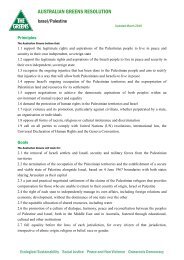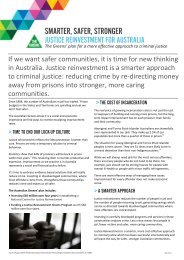news & views - Australian Greens
news & views - Australian Greens
news & views - Australian Greens
Create successful ePaper yourself
Turn your PDF publications into a flip-book with our unique Google optimized e-Paper software.
Autumn 2007 ISSUE 22 PAGE 20<br />
Grass roots<br />
communities<br />
as the heart of green citizenship<br />
Acting sustainably is dependent upon being part of a culture<br />
that sets the frame within which environmental decisions<br />
flow: a culture where environmental norms are embedded<br />
within our psyches and which set the range of options to<br />
explore.<br />
Retribalisation<br />
As a society we have over-reacted to the oppressive individualism<br />
of the tribes and villages of our history. In times of radical<br />
challenge to our ways of living, community development is<br />
one of the core political and cultural pathways forward. Green<br />
technology is laudable but insufficient, needing the structures<br />
of grass root communities to maximize its efficiencies - for<br />
example, five people sharing machinery, vehicles and appliances<br />
rather than owning individually.<br />
One of the core pathways for sustainability is regeneration of<br />
cities as clusters of villages. The word ‘community’ has been<br />
over-used, largely losing its meaning. Its regeneration is an<br />
essential strategy for human empowerment to tackle societies’<br />
restructuring. Community can be the context for challenging<br />
ingrained patterns resistant to transformation after 200 years<br />
of the god of economic growth. We need community; it’s our<br />
heritage of being human, vital to help radically reduce our<br />
footprint and to heal the human spirit. Virtual connections<br />
can only substitute so much and deepening relations with just<br />
one other is also insufficient.<br />
There have been numerous waves of experiments with intentional<br />
communities at times of crisis. I joined this search in<br />
the 1970s with many others. What I have so far learned from<br />
35 years’ experience of intentional community living is that<br />
collective strength comes from clarity of shared purpose. This<br />
can be sustained through organisational structures backed up<br />
by social pressure for individuals to participate and carry out<br />
their agreed tasks, with clear lines of responsibility and areas<br />
of authority. People may choose to join or to leave, but there<br />
need to be real community boundaries that limit the scope of<br />
diversity in order to ensure community cohesion.<br />
However, while core values need to be shared, the community<br />
structures need to allow for diversity. Diversity within an<br />
agreed framework is illustrated at Moora Moora by decisionmaking<br />
processes at meetings, by allowing for a diversity of<br />
ways of farming the land within a broadly agreed framework,<br />
and by respecting people’s decisions to be vegetarian or meateating.<br />
Cultural symbols and rituals<br />
P E T ER CO C K<br />
As citizens we are finally waking to the perils of our damage to the earth. However, our new consciousness<br />
is dragged down into inaction by isolation, cynicism and depression. This can occur when an individual is<br />
given responsibility disproportionate to his or her capacity to act constructively. It is too much to expect each<br />
individual to hold in isolation the energy to act radically and sustainably for the earth. We need the support of<br />
others to challenge the gaps between awareness and action. We have been socialised to live essentially private<br />
lives within impersonal worlds. We are largely devoid of the experience of intimate sharing beyond family<br />
whether of feelings, friends, flesh or possessions.<br />
Retribalisation involves complex interdependencies, not just<br />
‘the simple life’ and ‘self-sufficiency’. Community identity<br />
needs to be established and sustained through cultural symbols<br />
and rituals, often sacred. It takes a long time to rediscover<br />
and to evolve the shared realms of the sacred that nourish the<br />
community and sustain it during crisis. And – while rejecting<br />
corporate bureaucracy - communities must put in place clear<br />
structures and functions as a necessary first step towards the<br />
development of cultural features.<br />
At its heart community means shared bonding with a particular<br />
group of people in a particular place. Retribalisation from<br />
our present cultural base will involve struggle, pain, letting<br />
go and reaching out. In our culture we don’t know what 21st<br />
century tribalisation means and we therefore have so much to<br />
learn from other cultures that have a long experience of tribal<br />
village living.<br />
Much can also be learned from the longevity of religious communities.<br />
Whether their extremes of collective accountability<br />
and communal organisation are necessary for other communities<br />
is another matter. A transcendental community commitment<br />
of a spiritual, environmental and/or political nature<br />
is necessary for sustainability. At the very least communities












